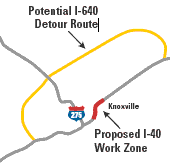U.S. Department of Transportation
Federal Highway Administration
1200 New Jersey Avenue, SE
Washington, DC 20590
202-366-4000
Federal Highway Administration Research and Technology
Coordinating, Developing, and Delivering Highway Transportation Innovations
 |
| This report is an archived publication and may contain dated technical, contact, and link information |
|
Publication Number: FHWA-HRT-05-142
Date: August 2005 |
PDF files can be viewed with the Acrobat® Reader®

The advantages of this option over more traditional approaches include reduced project duration, improved worker safety, and potential cost savings over more traditional approaches. However, the impact on road users throughout the closure period was poorly understood. From the road network geometry in the metropolitan area, it was clear that the brunt of the diverted traffic demand would have to be borne by I-640. TDOT commissioned a traffic study to predict traffic volumes on I-640 for a prospective 2008 full closure on I-40. The study used vehicle-matching technologies to identify through and local traffic volumes by collecting field data in the first half of 2004. The results of this study were used by analysts to better predict travel demands on I-640 during the construction period.
The study used QuickZone to identify the likelihood of significant congestion under the proposed full closure option by presenting a quick prediction based on current traffic volumes. When it became clear that congestion was likely to be significant, more refined traffic demand data and more detailed network geometry was applied in QuickZone. The increased scope identified the likely delay impacts and targets to assist the management of local and interstate traffic demand in preventing lengthy delays on I-640 and at the I-40/I-640 interchanges.
KEY OBSERVATIONS
QUICKZONE
Deborah Curtis
Federal Highway Administration (FHWA)
Operations, Research and Development
Integrated Product Team
202–493–3267
deborah.curtis@fhwa.dot.gov
CASE STUDY
Brian Fouch, P.E.
Region Three Area Engineer
FHWA–Tennessee Division
615–781–5765
brian.fouch@fhwa.dot.gov
Steve Allen
Transportation Manager 2
TDOT
615–741–2208
steve.allen@state.tn.us
